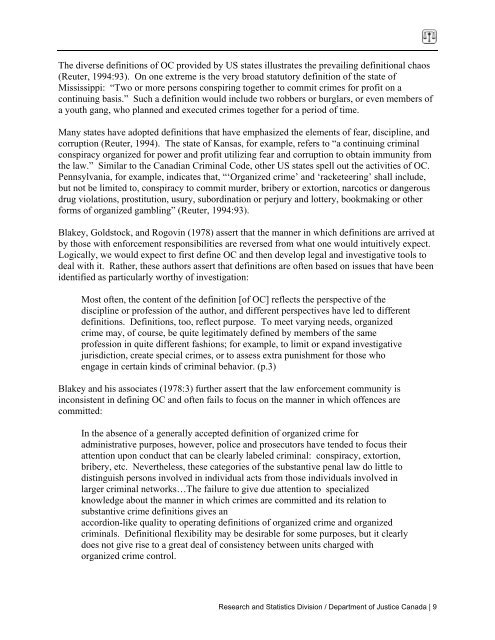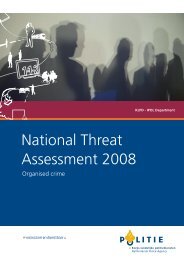Assessing the Effectiveness of Organized Crime Control Strategies ...
Assessing the Effectiveness of Organized Crime Control Strategies ...
Assessing the Effectiveness of Organized Crime Control Strategies ...
You also want an ePaper? Increase the reach of your titles
YUMPU automatically turns print PDFs into web optimized ePapers that Google loves.
The diverse definitions <strong>of</strong> OC provided by US states illustrates <strong>the</strong> prevailing definitional chaos<br />
(Reuter, 1994:93). On one extreme is <strong>the</strong> very broad statutory definition <strong>of</strong> <strong>the</strong> state <strong>of</strong><br />
Mississippi: “Two or more persons conspiring toge<strong>the</strong>r to commit crimes for pr<strong>of</strong>it on a<br />
continuing basis.” Such a definition would include two robbers or burglars, or even members <strong>of</strong><br />
a youth gang, who planned and executed crimes toge<strong>the</strong>r for a period <strong>of</strong> time.<br />
Many states have adopted definitions that have emphasized <strong>the</strong> elements <strong>of</strong> fear, discipline, and<br />
corruption (Reuter, 1994). The state <strong>of</strong> Kansas, for example, refers to “a continuing criminal<br />
conspiracy organized for power and pr<strong>of</strong>it utilizing fear and corruption to obtain immunity from<br />
<strong>the</strong> law.” Similar to <strong>the</strong> Canadian Criminal Code, o<strong>the</strong>r US states spell out <strong>the</strong> activities <strong>of</strong> OC.<br />
Pennsylvania, for example, indicates that, “‘<strong>Organized</strong> crime’ and ‘racketeering’ shall include,<br />
but not be limited to, conspiracy to commit murder, bribery or extortion, narcotics or dangerous<br />
drug violations, prostitution, usury, subordination or perjury and lottery, bookmaking or o<strong>the</strong>r<br />
forms <strong>of</strong> organized gambling” (Reuter, 1994:93).<br />
Blakey, Goldstock, and Rogovin (1978) assert that <strong>the</strong> manner in which definitions are arrived at<br />
by those with enforcement responsibilities are reversed from what one would intuitively expect.<br />
Logically, we would expect to first define OC and <strong>the</strong>n develop legal and investigative tools to<br />
deal with it. Ra<strong>the</strong>r, <strong>the</strong>se authors assert that definitions are <strong>of</strong>ten based on issues that have been<br />
identified as particularly worthy <strong>of</strong> investigation:<br />
Most <strong>of</strong>ten, <strong>the</strong> content <strong>of</strong> <strong>the</strong> definition [<strong>of</strong> OC] reflects <strong>the</strong> perspective <strong>of</strong> <strong>the</strong><br />
discipline or pr<strong>of</strong>ession <strong>of</strong> <strong>the</strong> author, and different perspectives have led to different<br />
definitions. Definitions, too, reflect purpose. To meet varying needs, organized<br />
crime may, <strong>of</strong> course, be quite legitimately defined by members <strong>of</strong> <strong>the</strong> same<br />
pr<strong>of</strong>ession in quite different fashions; for example, to limit or expand investigative<br />
jurisdiction, create special crimes, or to assess extra punishment for those who<br />
engage in certain kinds <strong>of</strong> criminal behavior. (p.3)<br />
Blakey and his associates (1978:3) fur<strong>the</strong>r assert that <strong>the</strong> law enforcement community is<br />
inconsistent in defining OC and <strong>of</strong>ten fails to focus on <strong>the</strong> manner in which <strong>of</strong>fences are<br />
committed:<br />
In <strong>the</strong> absence <strong>of</strong> a generally accepted definition <strong>of</strong> organized crime for<br />
administrative purposes, however, police and prosecutors have tended to focus <strong>the</strong>ir<br />
attention upon conduct that can be clearly labeled criminal: conspiracy, extortion,<br />
bribery, etc. Never<strong>the</strong>less, <strong>the</strong>se categories <strong>of</strong> <strong>the</strong> substantive penal law do little to<br />
distinguish persons involved in individual acts from those individuals involved in<br />
larger criminal networks…The failure to give due attention to specialized<br />
knowledge about <strong>the</strong> manner in which crimes are committed and its relation to<br />
substantive crime definitions gives an<br />
accordion-like quality to operating definitions <strong>of</strong> organized crime and organized<br />
criminals. Definitional flexibility may be desirable for some purposes, but it clearly<br />
does not give rise to a great deal <strong>of</strong> consistency between units charged with<br />
organized crime control.<br />
Research and Statistics Division / Department <strong>of</strong> Justice Canada | 9








